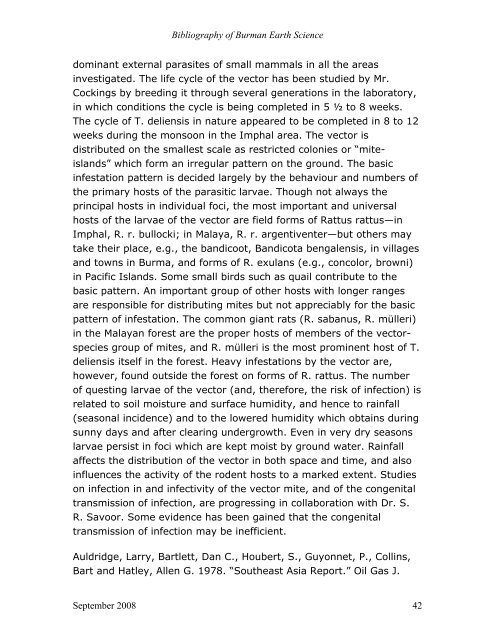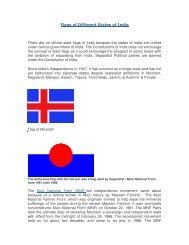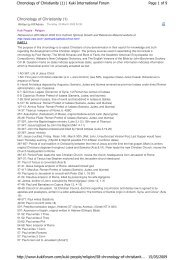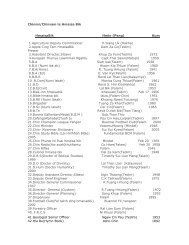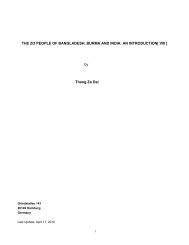The Geology of Burma - Zomi Online Library
The Geology of Burma - Zomi Online Library
The Geology of Burma - Zomi Online Library
Create successful ePaper yourself
Turn your PDF publications into a flip-book with our unique Google optimized e-Paper software.
Bibliography <strong>of</strong> <strong>Burma</strong>n Earth Science<br />
dominant external parasites <strong>of</strong> small mammals in all the areas<br />
investigated. <strong>The</strong> life cycle <strong>of</strong> the vector has been studied by Mr.<br />
Cockings by breeding it through several generations in the laboratory,<br />
in which conditions the cycle is being completed in 5 ½ to 8 weeks.<br />
<strong>The</strong> cycle <strong>of</strong> T. deliensis in nature appeared to be completed in 8 to 12<br />
weeks during the monsoon in the Imphal area. <strong>The</strong> vector is<br />
distributed on the smallest scale as restricted colonies or “miteislands”<br />
which form an irregular pattern on the ground. <strong>The</strong> basic<br />
infestation pattern is decided largely by the behaviour and numbers <strong>of</strong><br />
the primary hosts <strong>of</strong> the parasitic larvae. Though not always the<br />
principal hosts in individual foci, the most important and universal<br />
hosts <strong>of</strong> the larvae <strong>of</strong> the vector are field forms <strong>of</strong> Rattus rattus—in<br />
Imphal, R. r. bullocki; in Malaya, R. r. argentiventer—but others may<br />
take their place, e.g., the bandicoot, Bandicota bengalensis, in villages<br />
and towns in <strong>Burma</strong>, and forms <strong>of</strong> R. exulans (e.g., concolor, browni)<br />
in Pacific Islands. Some small birds such as quail contribute to the<br />
basic pattern. An important group <strong>of</strong> other hosts with longer ranges<br />
are responsible for distributing mites but not appreciably for the basic<br />
pattern <strong>of</strong> infestation. <strong>The</strong> common giant rats (R. sabanus, R. mülleri)<br />
in the Malayan forest are the proper hosts <strong>of</strong> members <strong>of</strong> the vectorspecies<br />
group <strong>of</strong> mites, and R. mülleri is the most prominent host <strong>of</strong> T.<br />
deliensis itself in the forest. Heavy infestations by the vector are,<br />
however, found outside the forest on forms <strong>of</strong> R. rattus. <strong>The</strong> number<br />
<strong>of</strong> questing larvae <strong>of</strong> the vector (and, therefore, the risk <strong>of</strong> infection) is<br />
related to soil moisture and surface humidity, and hence to rainfall<br />
(seasonal incidence) and to the lowered humidity which obtains during<br />
sunny days and after clearing undergrowth. Even in very dry seasons<br />
larvae persist in foci which are kept moist by ground water. Rainfall<br />
affects the distribution <strong>of</strong> the vector in both space and time, and also<br />
influences the activity <strong>of</strong> the rodent hosts to a marked extent. Studies<br />
on infection in and infectivity <strong>of</strong> the vector mite, and <strong>of</strong> the congenital<br />
transmission <strong>of</strong> infection, are progressing in collaboration with Dr. S.<br />
R. Savoor. Some evidence has been gained that the congenital<br />
transmission <strong>of</strong> infection may be inefficient.<br />
Auldridge, Larry, Bartlett, Dan C., Houbert, S., Guyonnet, P., Collins,<br />
Bart and Hatley, Allen G. 1978. “Southeast Asia Report.” Oil Gas J.<br />
September 2008 42


